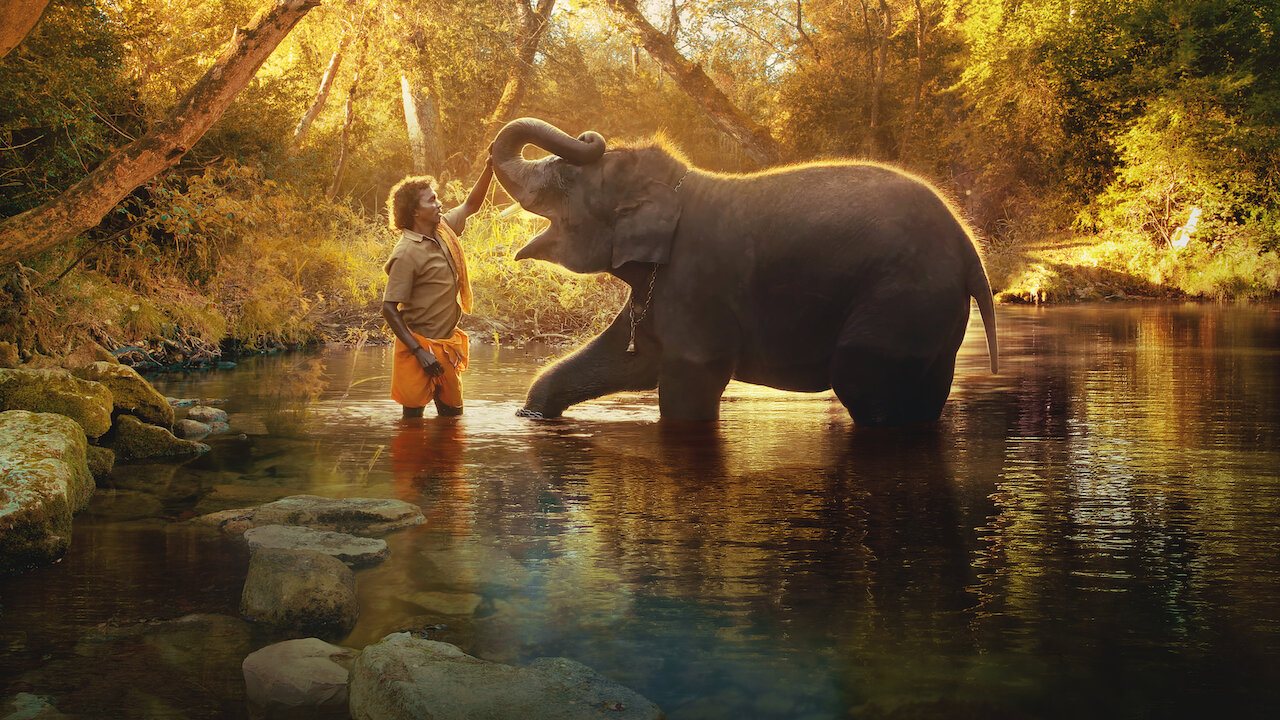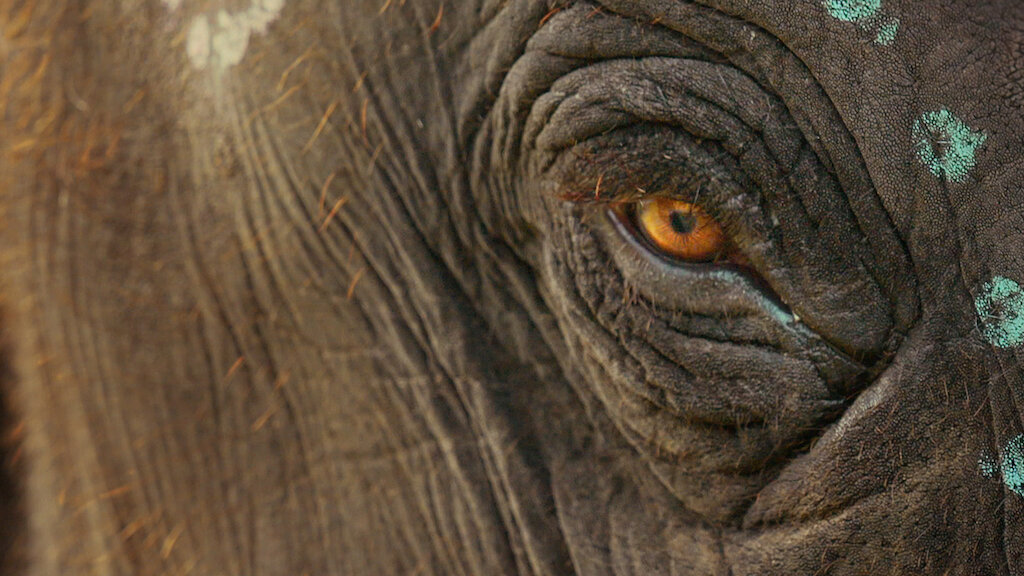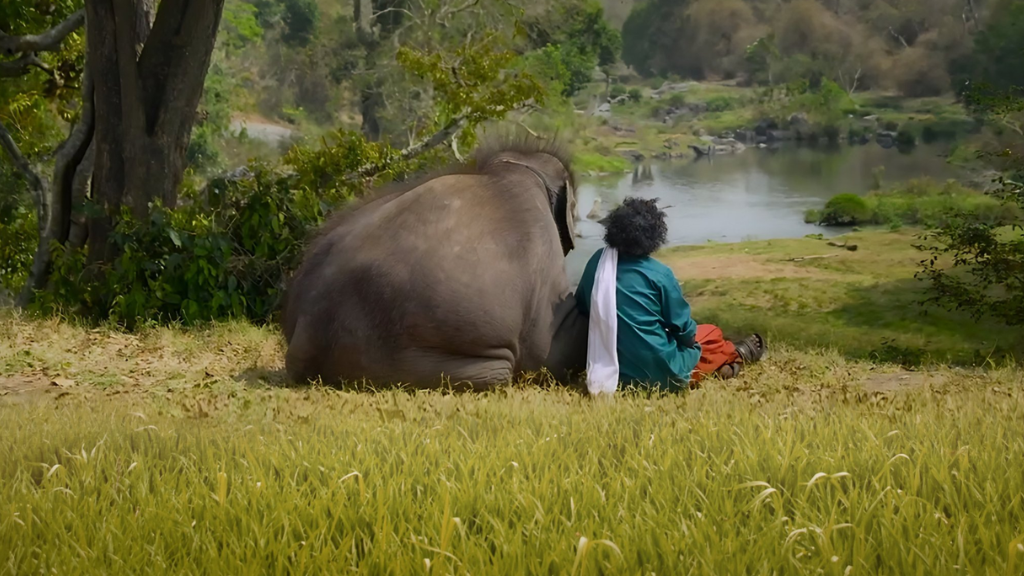THE ELEPHANT WHISPERERS
SUBJECTS — World History/other Cultures: India; the Environment.
SOCIAL-EMOTIONAL LEARNING — Caring for Animals, Grieving.
MORAL-ETHICAL EMPHASIS — Caring.
AGE; 9+
2022, 41 minutes; English; Available on Netflix.
There is NO AI content on this website. All content on TeachWithMovies.org has been written by human beings.
SUBJECTS — World History/other Cultures: India; the Environment.
SOCIAL-EMOTIONAL LEARNING — Caring for Animals, Grieving.
MORAL-ETHICAL EMPHASIS — Caring.
AGE; 9+
2022, 41 minutes; English; Available on Netflix.
TWM offers a worksheet for students to review before seeing the film and then to fill out after they have watched the movie. While not required for the lesson plan, teachers may want to review it. See Film Study Worksheet for an Informational Documentary at Film Study Worksheet for a Documentary.
Bomman and Bellie are from an indigenous tribe in the Tamil region of India who work for the Indian Forest Service. They save the lives of two orphaned baby elephants. Their story is inspiring and the images of the forest and its animals are exceptional.
Awards:
Best Documentary Short Subject at the 95th Academy Awards
Cast:
Bomman, Bellie, Raghu, Ammu
Director:
Kartiki Gonsalves
This film shows human beings from an indigenous culture doing good in the natural world by helping animals. Students will be able to observe elephants exhibiting a number of high-level functions such as affection, empathy, loyalty, grief, and the ability to respond to verbal commands.
The film leaves the misimpression that the Indian government’s Forest Service acted in a heartless manner when it assigned one of the elephants, Raghu, to another trainer. Bomman and Bellie had come to love him as if he were their child and they grieved at losing Raghu. In fact, Raghu had became an adolescent and there was a good reason for the Forest Service’s actions that are not shown in the film. This can be turned into a benefit by showing students that before making a judgment from something shown on the screen, they need to research the factual situation on their own. See the section on Using the Film in the Classroom.
Show this beautiful and engaging film to your children and explain why the Forrest Service assigned Raghu to a different caretaker when Raghu became an adolescent. See the section on Using the Film in the Classroom.

Raghu survived because Bomman and Bellie showered him with love, nursed him back to health, and saw to his every need. Many students will share the distress of Bomman and Bellie when the Forest Service assigns other trainers for Raghu and takes him away. However, adolescent male elephants require a very firm hand and need to be shown limits. In wild herds this parenting is provided by older male elephants, However, with orphaned elephants being trained by people, this discipline has to be supplied by the trainers. As the director of the film stated,
“As it gets into its adolescent years, it’s difficult for the same people who were showing so much love to be strict and stern with the same elephant. It’s different because when you have a pet dog, you can just be like, ‘No!’ and you have control. But when it’s something like an elephant that’s growing so rapidly, it’s very difficult because they live in such close proximity [to humans]. So, it’s something that they’ve got to be really careful about.” Quotes in Oscar-Contending Short ‘The Elephant Whisperers’ Centers On Indigenous Indian Couple And Their Sizeable Family by Matthew Carey, 12/15/22, Deadline, accessed 2/11/23.
Teachers and parents should point out that even in a film that appears to be only an informational documentary, sometimes important facts are left out or suppressed.
Bellie describes the strong similarities between human beings and elephants, “Everything about him is like a human except that he cannot talk.” Elephants are very intelligent and display a wide range of behaviors that show the essential unity of the animal kingdom. They feel affection, learn, can mimic others, play, act in an altruistic manner, act in a compassionate manner, grieve the death of loved ones, become depressed upon separation from loved ones, and cooperate with others. As Bellie says, “When you give them love, they give back to you in the same way.” In addition, elephants have complex mental maps, are self-aware, have good memories, can solve problems, understand pointing, and can communicate. Elephants can distinguish differences in human gender, age, and ethnicity purely by the sound of someone’s voice.
The story takes place in the Mudumali Tiger Preserve in the Tamil Nadu state in Southern India. The Theppakadu Elephant Camp is a tourist attraction where visitors can ride and feed elephants.
The monkeys with white fur shown in the film appear to be Grey Langur. A mahout is an elephant rider or trainer.
There are scenes in the film showing Ganesha, the “elephant-headed Hindu god of beginnings. Ganesha is traditionally worshipped before any major enterprise is begun. It is the patron of intellectuals, bankers, scribes, and authors. Its name means both “Lord of the People” (gana means the common people) and “Lord of the Ganas.” Ganesha is potbellied and generally depicted as holding in its hand a few round Indian sweets, of which it is inordinately fond. It is often shown mounted on or accompanied by the large Indian bandicoot rat, which symbolizes Ganesha’s ability to overcome anything to get what it wants. Like a rat and like an elephant, Ganesha is a remover of obstacles. Adapted from Encyclopedia Britannica article on Ganesha, https://www.britannica.com/topic/Ganesha.

1. [Ask this question several times, each time asking the class to come up with a different example.] Bellie says of Raghu, “Everything about him is like a human except that he cannot talk.” Provide an example from the film of elephants exhibiting behaviors showing what human beings consider to be “higher” functioning and our kinship to elephants.
Suggested Response:
Raghu follows instructions to lie down and bathe in a river; he tugs at Bellie’s clothes like a child; he engages in playful activity with water and with a ball; he submits to being washed with soap; he wipes away Bellie’s tears when she cries after her daughter dies; and he comes when called. Raghu is jealous when Ammu first comes to live with him, Bomman, and Bellie. However, Raghu and Ammu become close friends. Ammu gets upset, bellows, and tries to chase after Raghu when Forest Service trainers take Raghu away. Ammu grieves the separation from Raghu, not eating for several days. Ammu lies down on Bellie’s command next to Bellie to be embraced and petted. Krishna, another elephant removes a thorn that was stuck in Raghu’s tongue. Raghu, or perhaps it’s another elephant, submits to being scrubbed by children and then plays with them by spraying water.
2. How did Ammu show how she felt about Raghu leaving?
Suggested Response:
She bellowed. She tried to run after him. She didn’t eat properly for several days.
3. Raghu was sick and mutilated when he was found and turned over to Bomman and Bellie. How did he survive?
Suggested Response:
Bellie tells us. Bomman and Bellie formed a family around him.
4. How do Bomman and Bellie feel about Raghu.
Suggested Response:
They tell us. They love him like he was their child.

1. How does the effort of raising Raghu and Ammu help Bellie deal with the grief she felt over the death of her husband and her daughter?
Suggested Response:
Referring to the death of her first husband (who was killed by a tiger) and the death of her daughter, Bellie says, “I am not afraid of forest anymore. I had so much of loss and sadness in my life. But now I have found my way through it. I have found my voice. I have raised two baby elephants. Now everyone knows me as the mother of elephants and that makes me proud.” In other words, raising the baby elephants gave meaning to her life and, as she says, allowed her to find her way through the pain of immense loss.
1. This shows what can happen when people open their hearts to others.
Suggested Response:
They often receive love in return; it can help them through the grief of losing loved ones.
Students can be asked to investigate and write a report on the latest findings about any of the following:
Multimedia: Anchor Standard #7 for Reading (for both ELA classes and for History/Social Studies, Science, and Technical Classes). (The three Anchor Standards read: “Integrate and evaluate content presented in diverse media, including visually and quantitatively as well as in words.”) CCSS pp. 35 & 60. See also Anchor Standard # 2 for ELA Speaking and Listening, CCSS pg. 48.
Reading: Anchor Standards #s 1, 2, 7 and 8 for Reading and related standards (for both ELA classes and for History/Social Studies, Science, and Technical Classes). CCSS pp. 35 & 60.
Writing: Anchor Standards #s 1 – 5 and 7- 10 for Writing and related standards (for both ELA classes and for History/Social Studies, Science, and Technical Classes). CCSS pp. 41 & 63.
Speaking and Listening: Anchor Standards #s 1 – 3 (for ELA classes). CCSS pg. 48.
Not all assignments reach all Anchor Standards. Teachers are encouraged to review the specific standards to make sure that over the term all standards are met.
None.
None.
This Learning Guide was written by James A. Frieden. It was published on February 25, 2023
Benefits of the Movie
Possible Problems
Parenting Points
Selected Awards & Cast
Using the Movie in the Classroom
Discussion Questions
Social-Emotional Learning
Moral-Ethical Emphasis
Assignments and Projects
CCSS Anchor Standards
Bridges to Reading
Links to the Internet
Bibliography
TWM offers a worksheet for students to review before seeing the film and then to fill out after they have watched the movie. While not required for the lesson plan, teachers may want to review it. See Film Study Worksheet for a Documentary Seeking to Persuade the Viewer On a Matter of Political or Social Significance.
* we respect your privacy. no spam here!